A Framework for Predicting X-Nuclei Transmitter Gain Using 1H Signal
Abstract
1. Introduction
2. Materials and Methods
2.1. Transmitter Gain
2.2. Study Design
2.3. Statistics
3. Results
3.1. Sodium
3.2. Xenon
3.3. Carbon
4. Discussion
5. Conclusions
Author Contributions
Funding
Institutional Review Board Statement
Informed Consent Statement
Data Availability Statement
Acknowledgments
Conflicts of Interest
Appendix A
Appendix A.1. Study Design—Carbon Phantom Setup
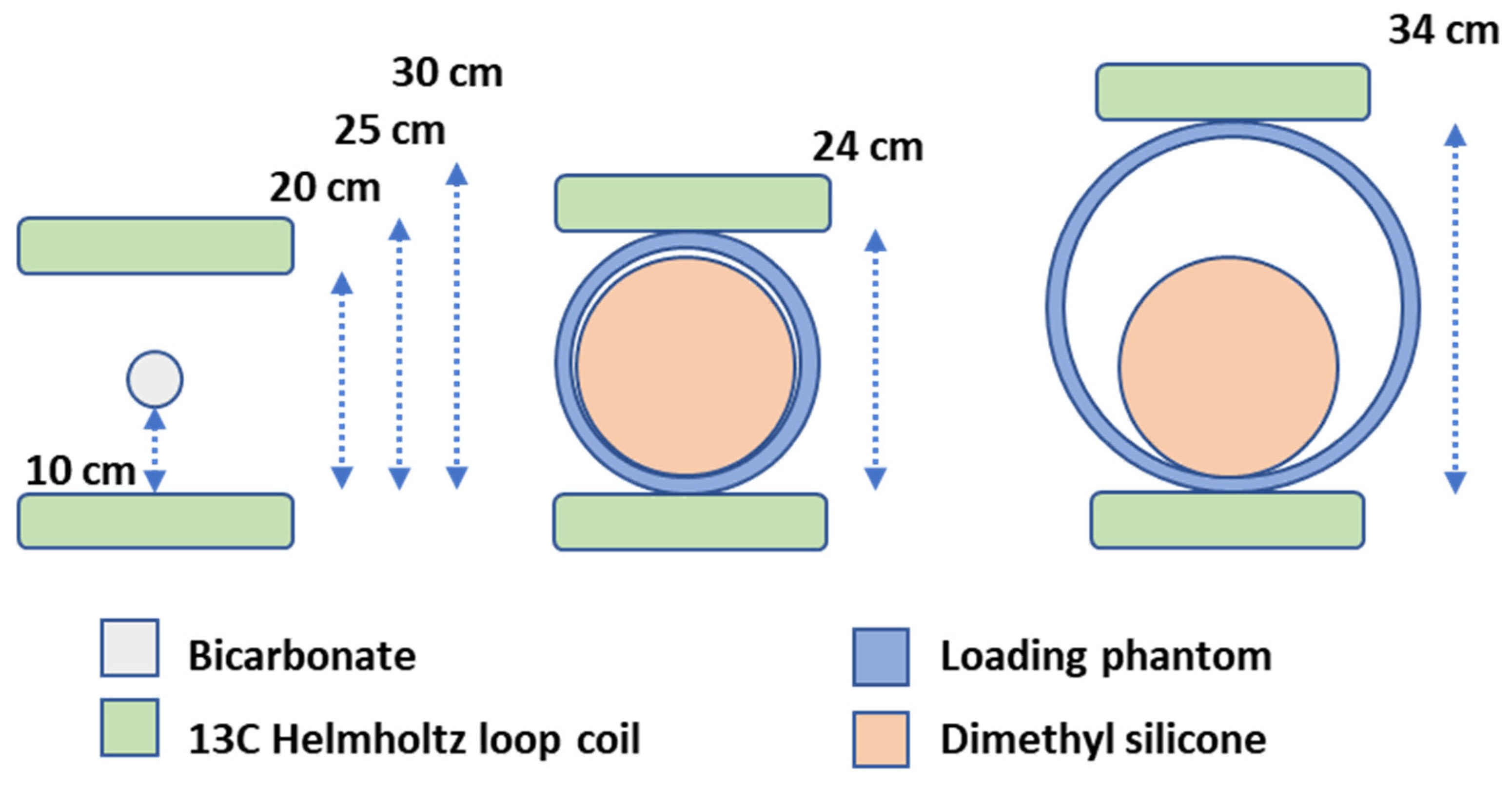
Appendix A.2. Results—Carbon Composite Functions
Appendix A.3. Discussion—X-Nuclei Linear Relationship
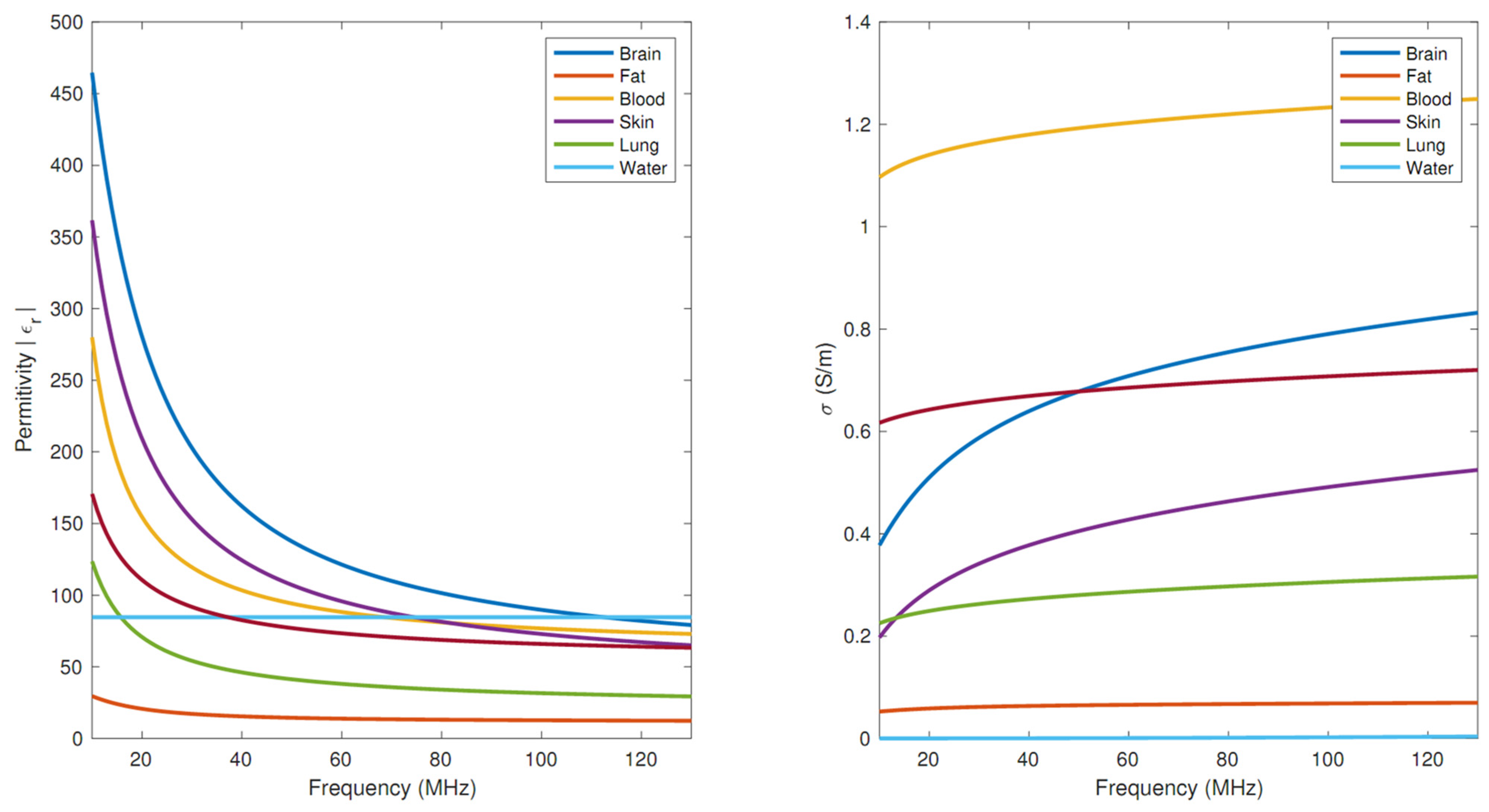
References
- Banks, W.P.; Company, H. Nutation Angle Measurement During Mri Prescan. Search 1980, 3–6. [Google Scholar]
- Gordon, J.W.; Chen, H.Y.; Dwork, N.; Tang, S.; Larson, P.E.Z. Fast Imaging for Hyperpolarized MR Metabolic Imaging. J. Magn. Reson. Imaging 2020, 53, 686–702. [Google Scholar] [CrossRef]
- Niedbalski, P.J.; Hall, C.S.; Castro, M.; Eddy, R.L.; Rayment, J.H.; Svenningsen, S.; Parraga, G.; Zanette, B.; Santyr, G.E.; Thomen, R.P.; et al. Protocols for multi-site trials using hyperpolarized 129Xe MRI for imaging of ventilation, alveolar-airspace size, and gas exchange: A position paper from the 129Xe MRI clinical trials consortium. Magn. Reson. Med. 2021, 86, 2966–2986. [Google Scholar] [CrossRef] [PubMed]
- Wang, Z.J.; Ohliger, M.A.; Larson, P.E.Z.; Gordon, J.W.; Bok, R.A.; Slater, J.; Villanueva-Meyer, J.E.; Hess, C.P.; Kurhanewicz, J.; Vigneron, D.B. Hyperpolarized 13C MRI: State of the art and future directions. Radiology 2019, 291, 273–284. [Google Scholar] [CrossRef] [PubMed]
- Perman, W.H.; Bernstein, M.A.; Sandstrom, J.C. A method for correctly setting the rf flip angle. Magn. Reson. Med. 1989, 9, 16–24. [Google Scholar] [CrossRef] [PubMed]
- Insko, E.K.; Bolinger, L. Mapping of the Radiofrequency Field. J. Magn. Reson. Ser. A 1993, 103, 82–85. [Google Scholar] [CrossRef]
- Yarnykh, V.L. Actual flip-angle imaging in the pulsed steady state: A method for rapid three-dimensional mapping of the transmitted radiofrequency field. Magn. Reson. Med. 2007, 57, 192–200. [Google Scholar] [CrossRef]
- Schulte, R.F.; Sacolick, L.; Deppe, M.H.; Janich, M.A.; Schwaiger, M.; Wild, J.M.; Wiesinger, F. Transmit gain calibration for nonproton MR using the Bloch-Siegert shift. NMR Biomed. 2011, 24, 1068–1072. [Google Scholar] [CrossRef]
- Bloch, F.; Siegert, A. Magnetic Resonance for Nonrotating Fields. Phys. Rev. 1940, 57, 522. [Google Scholar] [CrossRef]
- Markstaller, K.; Eberle, B.; Schreiber, W.G.; Weiler, N.; Thelen, M.; Kauczor, H.-U. Flip angle considerations in 3 Helium-MRI. NMR Biomed. 2000, 13, 190–193. [Google Scholar] [CrossRef]
- Wild, J.M.; Stewart, N.J.; Chan, H.F. Hyperpolarised helium-3 (3He) MRI: Physical methods for imaging human lung function. In MRI of the Lung, 2nd ed.; Kauczor, H.U., Wielpütz, M.O., Eds.; Springer: Cham, Swirzerland, 2018; pp. 69–97. [Google Scholar] [CrossRef]
- Rivoire, J.; Terekhov, M.; Meise, F.M.; Gast, K.; Salhi, Z.; Schreiber, L.M. Flip-angle measurement by magnetization inversion: Calibration of magnetization nutation angle in hyperpolarized 3He magnetic resonance imaging lung experiments. Magn. Reson. Med. 2011, 65, 399–408. [Google Scholar] [CrossRef] [PubMed]
- Zhang, B.; Wang, K.; Jiang, T. RF power design optimization in MRI system. Magn. Reson. Lett. 2021, 1, 89–98. [Google Scholar] [CrossRef]
- Gruber, B.; Froeling, M.; Leiner, T.; Klomp, D.W.J. RF coils: A practical guide for nonphysicists. J. Magn. Reson. Imaging 2018, 48, 590–604. [Google Scholar] [CrossRef] [PubMed]
- Grist, J.T.; McLean, M.A.; Riemer, F.; Schulte, R.F.; Deen, S.S.; Zaccagna, F.; Woitek, R.; Daniels, C.J.; Kaggie, J.D.; Matyz, T.; et al. Quantifying normal human brain metabolism using hyperpolarized [1–13 C]pyruvate and magnetic resonance imaging. Neuroimage 2019, 189, 171–179. [Google Scholar] [CrossRef] [PubMed]
- Cunningham, C.H.; Lau, J.Y.C.; Chen, A.P.; Geraghty, B.J.; Perks, W.J.; Roifman, I.; Wright, G.A.; Connelly, K.A. Hyperpolarized 13C Metabolic MRI of the Human Heart: Initial Experience. Circ. Res. 2016, 119, 1177–1182. [Google Scholar] [CrossRef] [PubMed]
- Autry, A.W.; Gordon, J.W.; Chen, H.Y.; LaFontaine, M.; Bok, R.; Van Criekinge, M.; Slater, J.B.; Carvajal, L.; Villanueva-Meyer, J.E.; Chang, S.M.; et al. Characterization of serial hyperpolarized 13C metabolic imaging in patients with glioma. NeuroImage Clin. 2020, 27, 102323. [Google Scholar] [CrossRef]
- Tran, M.; Latifoltojar, A.; Neves, J.B.; Papoutsaki, M.-V.; Gong, F.; Comment, A.; Costa, A.S.H.; Glaser, M.; Tran-Dang, M.-A.; El Sheikh, S.; et al. First-in-human in vivo non-invasive assessment of intra-tumoral metabolic heterogeneity in renal cell carcinoma. BJR Case Rep. 2019, 5, 20190003. [Google Scholar] [CrossRef]
- Wang, J.; Mao, W.; Qiu, M.; Smith, M.B.; Constable, R.T. Factors influencing flip angle mapping in MRI: RF pulse shape, slice-select gradients, off-resonance excitation, and B0 inhomogeneities. Magn. Reson. Med. 2006, 56, 463–468. [Google Scholar] [CrossRef]
- Sacolick, L.I.; Wiesinger, F.; Hancu, I.; Vogel, M.W. B1 mapping by Bloch-Siegert shift. Magn. Reson. Med. 2010, 63, 1315–1322. [Google Scholar] [CrossRef]
- Zhong, J.; Ruan, W.; Han, Y.; Sun, X.; Ye, C.; Zhou, X. Fast Determination of Flip Angle and T1 in Hyperpolarized Gas MRI during a Single Breath-Hold. Sci. Rep. 2016, 6, 25854. [Google Scholar] [CrossRef]
- Skloss, T. Phantom Fluids for High Field MR Imaging. Proc. Intl. Soc. Mag. Reson. 2004, 11, 1635. Available online: https://scholar.google.com/scholar?hl=en&q=Skloss+T.+Phantom+fluids+for+high+field+MR+imaging.+In+Proceedings+of+the+12th+Annual+Meeting+of+ISMRM%2C+Kyoto%2C+Japan%2C+2004.+p.+1635 (accessed on 27 June 2022).
- Crosser, M.S.; Scott, S.; Clark, A.; Wilt, P.M. On the magnetic field near the center of Helmholtz coils. Rev. Sci. Instrum. 2010, 81, 084701. [Google Scholar] [CrossRef] [PubMed]
- Bashir, A.; Conradi, M.S.; Woods, J.C.; Quirk, J.D.; Yablonskiy, D.A. Calibration of RF transmitter voltages for hyperpolarized gas MRI. Magn. Reson. Med. 2009, 61, 239–243. [Google Scholar] [CrossRef] [PubMed]
- Wild, J.M.; Fichele, S.; Woodhouse, N.; Paley, M.N.J.; Kasuboski, L.; van Beek, E.J.R. 3D volume-localized pO2 measurement in the human lung with3He MRI. Magn. Reson. Med. 2005, 53, 1055–1064. [Google Scholar] [CrossRef] [PubMed]
- Bansal, N.; Szczepaniak, L.; Ternullo, D.; Fleckenstein, J.L.; Malloy, C.R. Effect of exercise on 23Na MRI relaxation characteristics of the human calf muscle. J. Magn. Reson. Imaging 2000, 11, 532–538. [Google Scholar] [CrossRef]
- Grist, J.T.; Riemer, F.; Hansen, E.S.S.; Tougaard, R.S.; McLean, M.A.; Kaggie, J.; Bøgh, N.; Graves, M.J.; Gallagher, F.A.; Laustsen, C. Visualization of sodium dynamics in the kidney by magnetic resonance imaging in a multi-site study. Kidney Int. 2020, 98, 1174. [Google Scholar] [CrossRef]
- Miloushev, V.Z.; Granlund, K.L.; Boltyanskiy, R.; Lyashchenko, S.K.; DeAngelis, L.M.; Mellinghoff, I.K.; Brennan, C.W.; Tabar, V.; Yang, T.J.; Holodny, A.I.; et al. Metabolic imaging of the human brain with hyperpolarized 13C Pyruvate demonstrates 13C lactate production in brain tumor patients. Cancer Res. 2018, 78, 3755–3760. [Google Scholar] [CrossRef]
- Collier, G.J.; Schulte, R.F.; Rao, M.; Norquay, G.; Ball, J.; Wild, J.M. Imaging gas-exchange lung function and brain tissue uptake of hyperpolarized 129Xe using sampling density-weighted MRSI. Magn. Reson. Med. 2023, 89, 2217–2226. [Google Scholar] [CrossRef]
- Fujita, H.; Zheng, T.; Yang, X.; Finnerty, M.J.; Handa, S. RF surface receive array coils: The art of an LC circuit. J. Magn. Reson. Imaging 2013, 38, 12–25. [Google Scholar] [CrossRef]
- Akoka, S.; Franconi, F.; Seguin, F.; Le Pape, A. Radiofrequency map of an NMR coil by imaging. Magn. Reson. Imaging 1993, 11, 437–441. [Google Scholar] [CrossRef]
- Bottomley, P.A.; Griffiths, J.R. Handbook of Magnetic Resonance Spectroscopy In Vivo: MRS Theory, Practice and Applications; John Wiley & Sons: Hoboken, NJ, USA, 2016; ISBN 9781118997666. [Google Scholar]
- Albert, M.S.; Cates, G.D.; Driehuys, B.; Happer, W.; Saam, B.; Springer, C.S.; Wishnia, A. Biological magnetic resonance imaging using laser-polarized 129Xe. Nature 1994, 370, 199–201. [Google Scholar] [CrossRef] [PubMed]
- Driehuys, B.; Cates, G.D.; Miron, E.; Sauer, K.; Walter, D.K.; Happer, W. High-volume production of laser-polarized 129 Xe. Appl. Phys. Lett. 1996, 69, 1668–1670. [Google Scholar] [CrossRef]
- Ardenkjær-Larsen, J.H.; Fridlund, B.; Gram, A.; Hansson, G.; Hansson, L.; Lerche, M.H.; Servin, R.; Thaning, M.; Golman, K. Increase in signal-to-noise ratio of >10,000 times in liquid-state NMR. Proc. Natl. Acad. Sci. USA 2003, 100, 10158–10163. [Google Scholar] [CrossRef] [PubMed]

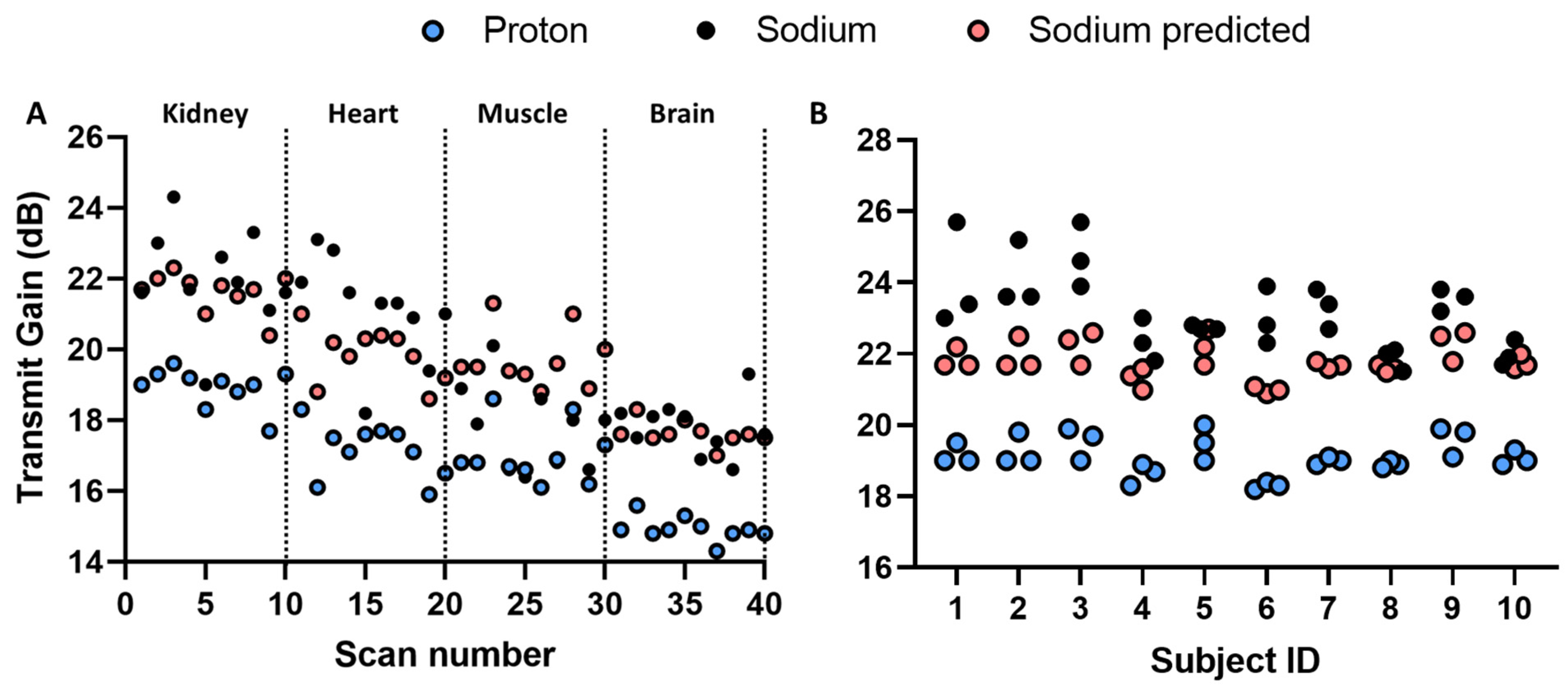
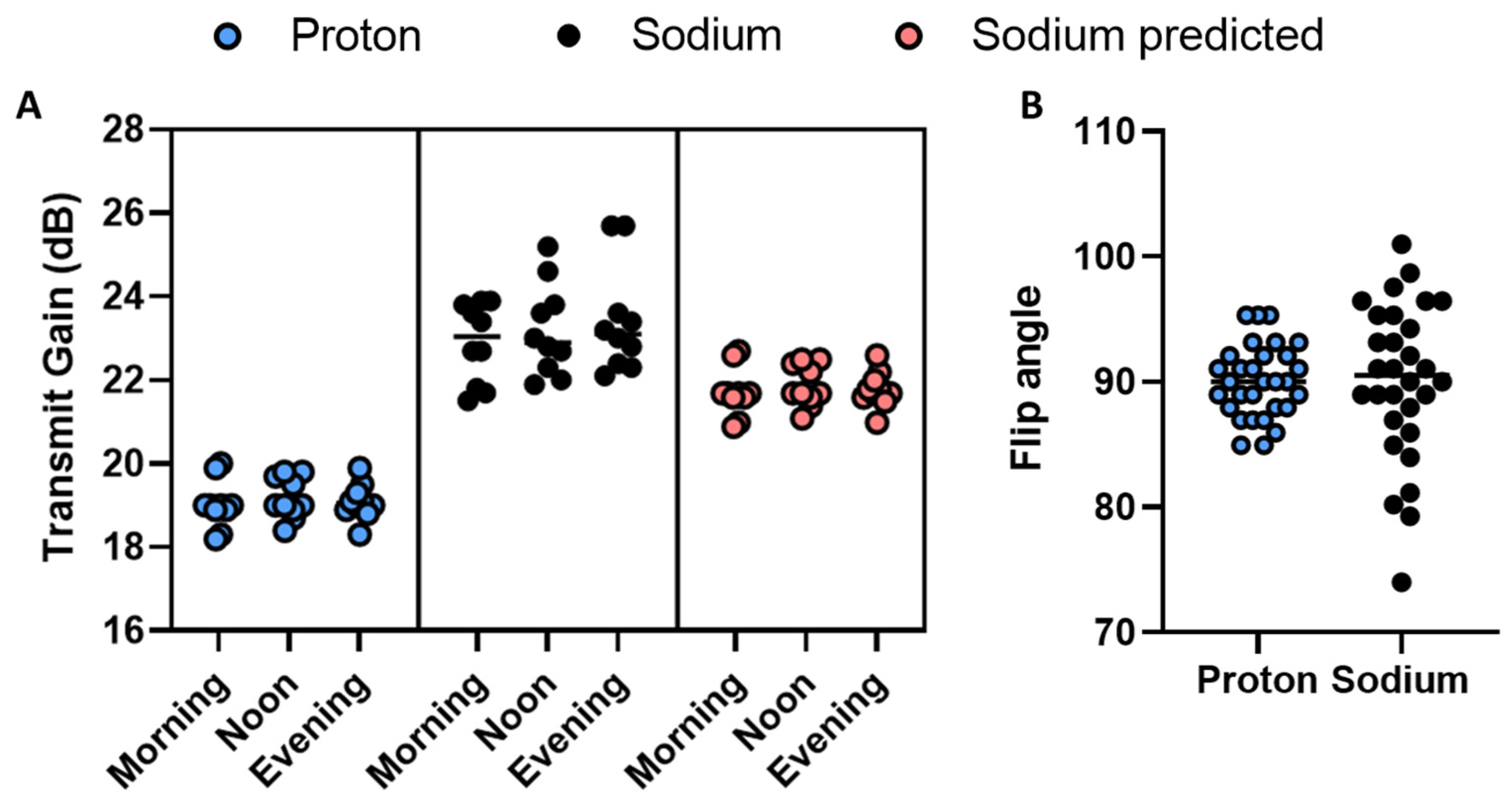
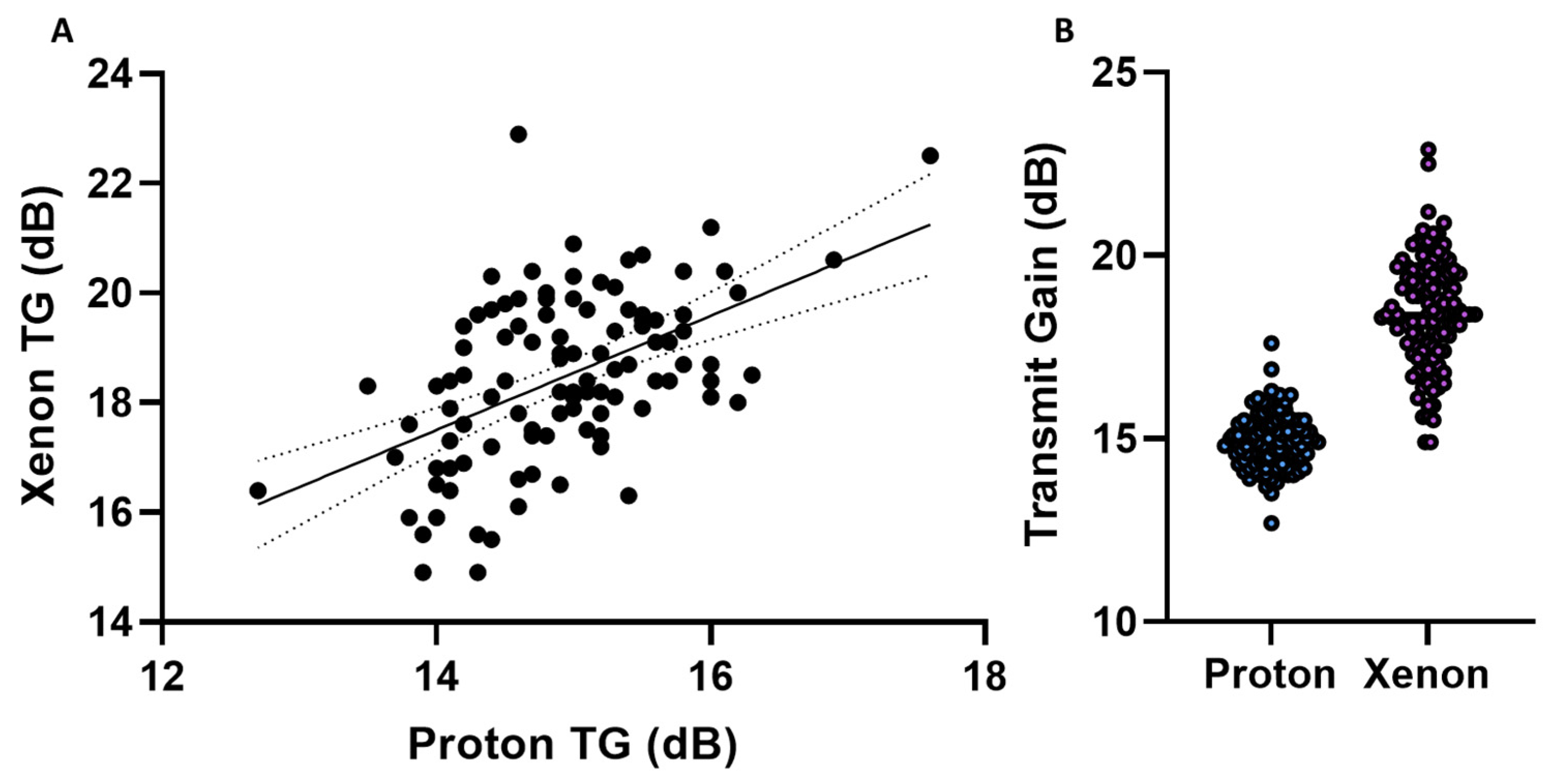

| Nuclei | Method | Pros and Cons |
|---|---|---|
| Hyperpolarised Helium (3He) | A one-time procedure using a pickup coil and a 3He phantom [24,25]. | Pro: Easy to set up for each coil providing transmitter settings without the use of hyperpolarised helium gas. Con: Use subject weight as loading and may introduce a bias given the difference in body coil and X-nuclei loading. |
| Sodium (23Na) | Natural abundance X-nuclei prescan of or default values [8,26,27]. | Pro: Sodium signal has a high natural abundance in vivo making the signal renewable. Given the low sensitivity, the addition in time is limited compared to imaging acquisition time. Con: A dedicated X-nuclei scan needs to be performed per subject introducing workflow complexity. |
| Hyperpolarised Carbon (13C) | Using phantoms (e.g., urea or bicarbonate) or historical default values [16,18,28]. | Pro: Ability to set transmitter settings without the use of hyperpolarised carbon. Con: Phantoms are placed away from the region of interest, introducing a bias. Default values may vary significantly in the abdominal and thoracic regions. |
| Hyperpolarised Xenon (129Xe) | X-nuclei prescan using low-concentration hyperpolarised xenon [3,29]. | Pro: Provides in vivo pulmonary calibration of the xenon gas calibration. Con: Requires administration of an additional hyperpolarised xenon gas dose. |
Disclaimer/Publisher’s Note: The statements, opinions and data contained in all publications are solely those of the individual author(s) and contributor(s) and not of MDPI and/or the editor(s). MDPI and/or the editor(s) disclaim responsibility for any injury to people or property resulting from any ideas, methods, instructions or products referred to in the content. |
© 2023 by the authors. Licensee MDPI, Basel, Switzerland. This article is an open access article distributed under the terms and conditions of the Creative Commons Attribution (CC BY) license (https://creativecommons.org/licenses/by/4.0/).
Share and Cite
Vaeggemose, M.; Schulte, R.F.; Hansen, E.S.S.; Miller, J.J.; Rasmussen, C.W.; Pilgrim-Morris, J.H.; Stewart, N.J.; Collier, G.J.; Wild, J.M.; Laustsen, C. A Framework for Predicting X-Nuclei Transmitter Gain Using 1H Signal. Tomography 2023, 9, 1603-1616. https://doi.org/10.3390/tomography9050128
Vaeggemose M, Schulte RF, Hansen ESS, Miller JJ, Rasmussen CW, Pilgrim-Morris JH, Stewart NJ, Collier GJ, Wild JM, Laustsen C. A Framework for Predicting X-Nuclei Transmitter Gain Using 1H Signal. Tomography. 2023; 9(5):1603-1616. https://doi.org/10.3390/tomography9050128
Chicago/Turabian StyleVaeggemose, Michael, Rolf F. Schulte, Esben S. S. Hansen, Jack J. Miller, Camilla W. Rasmussen, Jemima H. Pilgrim-Morris, Neil J. Stewart, Guilhem J. Collier, Jim M. Wild, and Christoffer Laustsen. 2023. "A Framework for Predicting X-Nuclei Transmitter Gain Using 1H Signal" Tomography 9, no. 5: 1603-1616. https://doi.org/10.3390/tomography9050128
APA StyleVaeggemose, M., Schulte, R. F., Hansen, E. S. S., Miller, J. J., Rasmussen, C. W., Pilgrim-Morris, J. H., Stewart, N. J., Collier, G. J., Wild, J. M., & Laustsen, C. (2023). A Framework for Predicting X-Nuclei Transmitter Gain Using 1H Signal. Tomography, 9(5), 1603-1616. https://doi.org/10.3390/tomography9050128






